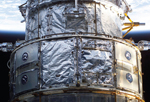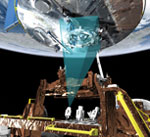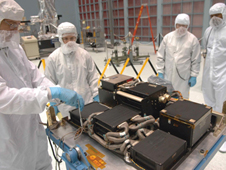Rate Sensor Units (Gyroscopes)
 The gyroscopes are part of Hubble's pointing system. They provide a frame of reference for Hubble to determine where it is pointing and how that pointing changes as the telescope moves across the sky. They report any small movements of the spacecraft to Hubble's pointing and Control System. The computer then commands the spinning reaction wheels to keep the spacecraft stable or moving at the desired rate. The gyroscopes work by sensing Hubble's motion relative to the axes of the spinning masses inside the gyroscopes. In the absence of external torques, these axes remain stable relative to the fixed stars in the sky. By keeping Hubble fixed relative to these axes, Hubble stays stable relative to the stars. The gyroscopes are part of Hubble's pointing system. They provide a frame of reference for Hubble to determine where it is pointing and how that pointing changes as the telescope moves across the sky. They report any small movements of the spacecraft to Hubble's pointing and Control System. The computer then commands the spinning reaction wheels to keep the spacecraft stable or moving at the desired rate. The gyroscopes work by sensing Hubble's motion relative to the axes of the spinning masses inside the gyroscopes. In the absence of external torques, these axes remain stable relative to the fixed stars in the sky. By keeping Hubble fixed relative to these axes, Hubble stays stable relative to the stars.
|
+ Read More
+ NASA Fact Sheet (PDF) |
| Fine Guidance Sensors (FGSs)
 Hubble uses Fine Guidance Sensors (FGS) for steady pointing and measurement. Astronauts will exchange one of these optical sensors with a refurbished unit that has enhanced, on-orbit alignment capability. The new unit is a refurbished version of the one that was returned from Servicing Mission 3A in 1999. Hubble uses Fine Guidance Sensors (FGS) for steady pointing and measurement. Astronauts will exchange one of these optical sensors with a refurbished unit that has enhanced, on-orbit alignment capability. The new unit is a refurbished version of the one that was returned from Servicing Mission 3A in 1999.
|
+ Read More
+ NASA Fact Sheet (PDF) |
| Batteries
 Each battery consists of 22 cells in series along with heaters, heater controllers, pressure measurement transducers and electronics, and temperature-measuring devices and their associated electronics. Three batteries are packaged into a module measuring roughly 36 by 32 by 11 in. (90 x 90 x 25 cm) and weighing about 460 lb (214 kg). Each module is equipped with two large yellow handles that astronauts use to maneuver the module in and out of the Telescope in space. Each battery consists of 22 cells in series along with heaters, heater controllers, pressure measurement transducers and electronics, and temperature-measuring devices and their associated electronics. Three batteries are packaged into a module measuring roughly 36 by 32 by 11 in. (90 x 90 x 25 cm) and weighing about 460 lb (214 kg). Each module is equipped with two large yellow handles that astronauts use to maneuver the module in and out of the Telescope in space.
|
+ Read More
+ NASA Fact Sheet (PDF) |
| NOBL
 The New Outer Blanket Layer (NOBL) covers protect Hubble external blankets. They prevent further degradation of the insulation and maintain normal operating temperatures. Each NOBL has been tested to ensure that it can withstand exposure to: charged particles, X-rays, ultraviolet radiation, and thermal cycling for at least ten years.
The New Outer Blanket Layer (NOBL) covers protect Hubble external blankets. They prevent further degradation of the insulation and maintain normal operating temperatures. Each NOBL has been tested to ensure that it can withstand exposure to: charged particles, X-rays, ultraviolet radiation, and thermal cycling for at least ten years.
During the Hubble Space Telescope Second Servicing Mission in 1997 and subsequent missions, astronauts detected damage to some of the telescope thermal insulation. Years of exposure to the harsh environment of space had taken a toll on Hubble protective multi-layer insulation, and some areas were torn or broken.
During Servicing Mission 3A in 1999, astronauts installed three NOBLs on damaged areas. During Servicing Mission 3B in March 2002, a fourth NOBL was installed. Additional NOBL panels will be installed during Servicing Mission 4.
|
+ Read More
+ NASA Fact Sheet (PDF)
|
| SCRS
 The Soft Capture and Rendezvous System (SCRS) is new hardware designed for future use in safely de-orbiting Hubble at the end of its mission life. Originally planned for Earth return on the Shuttle, Hubble's scientific life will now extend to 2014, beyond the planned retirement date of the Shuttle in 2010. The Soft Capture and Rendezvous System (SCRS) is new hardware designed for future use in safely de-orbiting Hubble at the end of its mission life. Originally planned for Earth return on the Shuttle, Hubble's scientific life will now extend to 2014, beyond the planned retirement date of the Shuttle in 2010.
The SCRS is comprised of two separate pieces:
- Soft Capture Mechanism (SCM) - a ring-like device which will be permanently attached to Hubble's aft bulkhead,
- Relative Navigation System (RNS) - an imaging system consisting of optical and navigation sensors and supporting avionics that will be mounted on the Shuttle to record Hubble's capture and deployment during SM4.
The SCM will permit docking of a future vehicle or attachment of a propulsion module for a controlled and safe de-orbit. The data obtained from the RNS will be used in developing the navigation systems of the spacecraft that will de-orbit Hubble when the telescope reaches the end of its useful life.
|
+ Read More
+ NASA Fact Sheet (PDF)
|
| SIC&DH
 The Science Instrument Command and Data Handling (SIC&DH) provides all of the electronics to command Hubble's science instruments from the ground and to flow science and engineering data back to the ground. The Science Instrument Command and Data Handling (SIC&DH) provides all of the electronics to command Hubble's science instruments from the ground and to flow science and engineering data back to the ground.
On September 27, 2008 the "A" side of the redundant SIC&DH suffered a permanent electronic failure. The "B" side was activated on October 23, 2008. But because the SIC&DH is such a critical part of Hubble's science capability, the October 2008 mission was postponed in order to allow engineers time to prepare the spare SIC&DH for inclusion into the servicing mission.
|
+ Read More
+ NASA Fact Sheet (PDF)
|